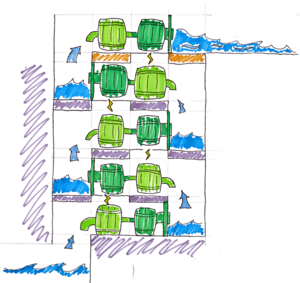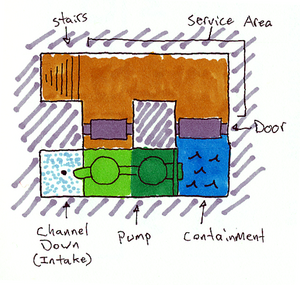- v50 information can now be added to pages in the main namespace. v0.47 information can still be found in the DF2014 namespace. See here for more details on the new versioning policy.
- Use this page to report any issues related to the migration.
Difference between revisions of "v0.31:Screw pump"
m (Cleaned up stub) |
LemonFrosted (talk | contribs) (Added section on Pump Stack and re-instated the old summary information.) |
||
| Line 1: | Line 1: | ||
{{av}} | {{av}} | ||
| − | Pumps will transfer power vertically as they did in 40d. It is confirmed they function in all respects as they did in the previous version. | + | Note: Pumps will transfer power vertically as they did in 40d. It is confirmed they function in all respects as they did in the previous version. For information on vertical power transfer see Pump Stack below. |
| + | {{Machine_component|name=Screw pump|key=s|job=[[40d:Pump operator|Pump operator]] | ||
| + | |construction= | ||
| + | * [[DF2010:Enormous corkscrew|Enormous corkscrew]] | ||
| + | * [[DF2010:Pipe|Pipe]] | ||
| + | * [[DF2010:Block|Block]] | ||
| + | |construction_job= | ||
| + | * [[DF2010:Architecture|Architecture]] | ||
| + | * 1 of | ||
| + | ** [[DF2010:Carpentry|Carpentry]] | ||
| + | ** [[DF2010:Masonry|Masonry]] | ||
| + | |power=Needs 10 power. | ||
| + | }} | ||
| + | |||
| + | A '''screw pump''' is a small [[DF2010:building|building]] that can lift liquids ([[DF2010:water|water]] or [[DF2010:magma|magma]]) from one level below onto the same [[DF2010:Z-level|Z-level]] as the pump. It is two tiles by one tile in size, and it can be either manually operated by a [[DF2010:dwarf|dwarf]] with the [[40d:pump operator|pump operator]] job or by using [[DF2010:gear assembly|gear assemblies]] connected to [[DF2010:water wheel|water wheel]]s and/or [[DF2010:windmill|windmill]]s. | ||
| + | |||
| + | The direction you want the fluid to travel must be chosen at the time of construction. Pumping only occurs in a straight line, and involves a total of 4 tiles in a row - the liquid source, two for the pump, and the output. The "rise" in levels occurs on the first tile, the intake side, from one level below up to the level of the pump*. Pumped fluids can and will flow immediately after being pumped, as normal for that fluid. Pumped fluids will have a [[DF2010:pressure|pressure]] equal to the exit [[DF2010:z-level|z-level]] - a pump never "forces" water to a higher [[DF2010:z-level|z-level]] than the output tile. | ||
| + | |||
| + | :''(* A DF pump can best be imagined as a simple [http://en.wikipedia.org/wiki/Archimedes%27_screw archimedes screw].)'' | ||
| + | |||
| + | Salt water pumped through a pump will become drinkable if then kept separate from natural walls, natural floors, other salt water or an aquifer. | ||
| + | |||
| + | ''For a basic overview of how the different machine parts work and work together, see [[DF2010:machinery|machinery]].'' | ||
| + | |||
| + | |||
| + | ==Pump Stack== | ||
[[File:PumpStack2010.png|thumb|right|300px|'''Illustrated Side View of a Pump Stack'''.]] | [[File:PumpStack2010.png|thumb|right|300px|'''Illustrated Side View of a Pump Stack'''.]] | ||
| + | [[File:PumpStackTopView.png|thumb|right|300px|'''Illustrated Top View of a Pump Stack Layer'''.]] | ||
| + | A Pump Stack is a method used to draw water or magma vertically across multiple z-levels requiring a minimum of parts. The basic functionality is possible because the Output (dark) side of the pump can be built over open space with a machine component located directly below, in this case another Screw Pump. Note that for power to properly transfer the intake (light) side of the pump must line up with the output (dark) side of the pump on the floor above it through a space in the floor, as in the illustration. | ||
| + | |||
| + | A pump stack minimizes the amount of machinery required to lift water or magma by allowing for power to be supplied directly to only the most accessible pump (typically the topmost) which in turn allows the player to operate a stack limited only by how many windmills/water wheels they can fit into the area. | ||
| + | |||
| + | Typical applications for a pump stack include moving magma from a lower level up to a convenient level for forges and furnaces, extracting water from a flooded fort, raising water for a decorative waterfall (and extracting it afterwards), or any other purpose that requires water/magma on a z-level significantly above its current location. | ||
| + | |||
| + | The Illustrated Top View of a Pump Stack Layer shows a basic section of a pump stack. Only the door (or a floodgate) on the Containment side is strictly necessary in order to prevent flooding. Two doorways are used here, each lining up with the solid ground within the pump assembly, in order to prevent workers from trapping themselves after digging channels or assembling the pump. | ||
Revision as of 16:49, 8 April 2010
| This article is about an older version of DF. |
Note: Pumps will transfer power vertically as they did in 40d. It is confirmed they function in all respects as they did in the previous version. For information on vertical power transfer see Pump Stack below.
|
b-M-s | |||||||
| |||||||
| Job Requirement | |||||||
|---|---|---|---|---|---|---|---|
| Construction | |||||||
| Materials | Jobs | ||||||
| |||||||
| Power | |||||||
|
Needs 10 power. | |||||||
A screw pump is a small building that can lift liquids (water or magma) from one level below onto the same Z-level as the pump. It is two tiles by one tile in size, and it can be either manually operated by a dwarf with the pump operator job or by using gear assemblies connected to water wheels and/or windmills.
The direction you want the fluid to travel must be chosen at the time of construction. Pumping only occurs in a straight line, and involves a total of 4 tiles in a row - the liquid source, two for the pump, and the output. The "rise" in levels occurs on the first tile, the intake side, from one level below up to the level of the pump*. Pumped fluids can and will flow immediately after being pumped, as normal for that fluid. Pumped fluids will have a pressure equal to the exit z-level - a pump never "forces" water to a higher z-level than the output tile.
- (* A DF pump can best be imagined as a simple archimedes screw.)
Salt water pumped through a pump will become drinkable if then kept separate from natural walls, natural floors, other salt water or an aquifer.
For a basic overview of how the different machine parts work and work together, see machinery.
Pump Stack
A Pump Stack is a method used to draw water or magma vertically across multiple z-levels requiring a minimum of parts. The basic functionality is possible because the Output (dark) side of the pump can be built over open space with a machine component located directly below, in this case another Screw Pump. Note that for power to properly transfer the intake (light) side of the pump must line up with the output (dark) side of the pump on the floor above it through a space in the floor, as in the illustration.
A pump stack minimizes the amount of machinery required to lift water or magma by allowing for power to be supplied directly to only the most accessible pump (typically the topmost) which in turn allows the player to operate a stack limited only by how many windmills/water wheels they can fit into the area.
Typical applications for a pump stack include moving magma from a lower level up to a convenient level for forges and furnaces, extracting water from a flooded fort, raising water for a decorative waterfall (and extracting it afterwards), or any other purpose that requires water/magma on a z-level significantly above its current location.
The Illustrated Top View of a Pump Stack Layer shows a basic section of a pump stack. Only the door (or a floodgate) on the Containment side is strictly necessary in order to prevent flooding. Two doorways are used here, each lining up with the solid ground within the pump assembly, in order to prevent workers from trapping themselves after digging channels or assembling the pump.

